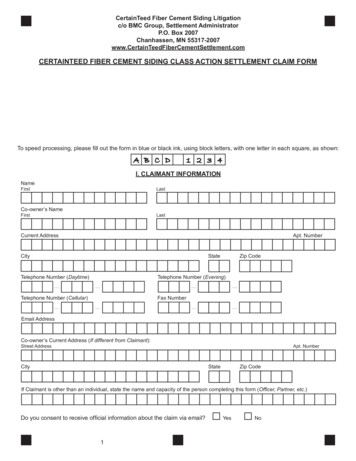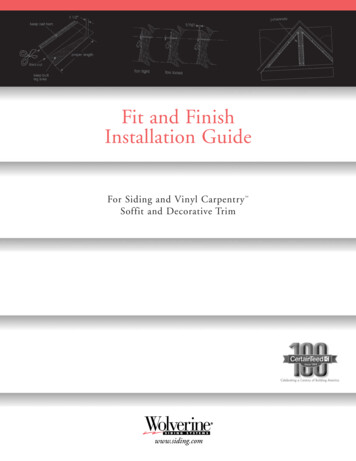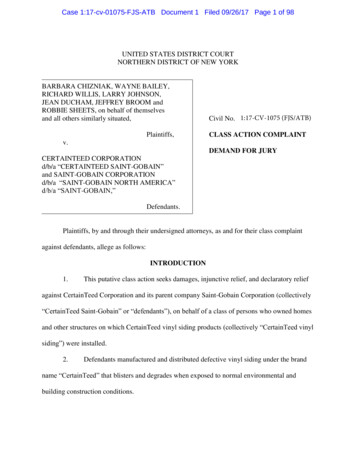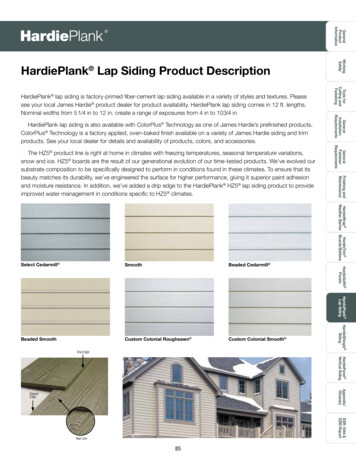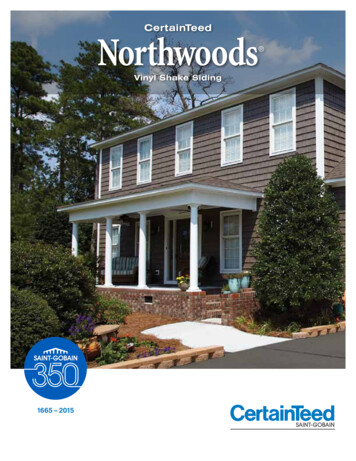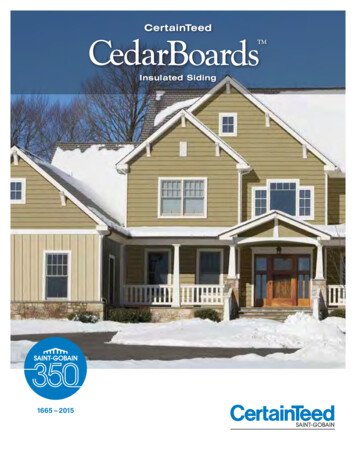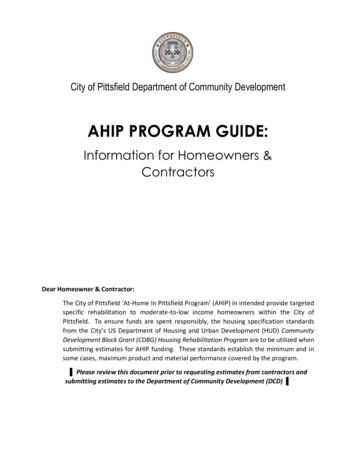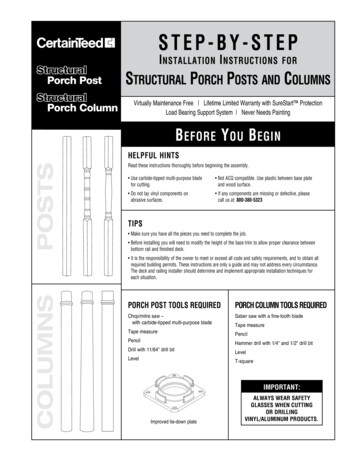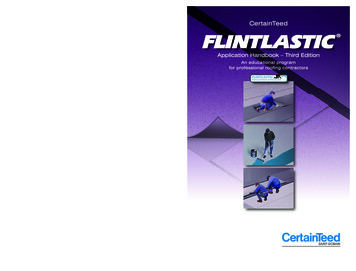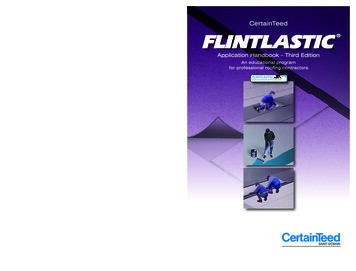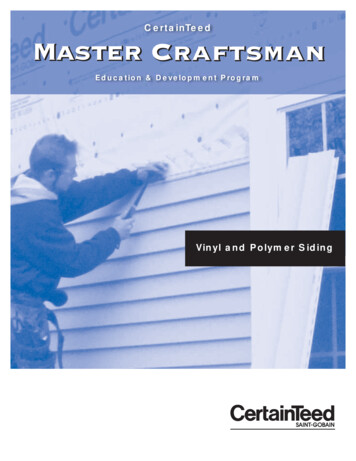
Transcription
CertainTeedEducation & Development ProgramVinyl and Polymer Siding
Become a CertainTeedThe Master Craftsman Education and DevelopmentWorkbook is the only training manual of its kind inthe industry, and it is brought to you by CertainTeed.Use it to master the information critical to a thoroughunderstanding of CertainTeed’s line of siding, soffit, andaccessories and their installation. Also, a mastery of thisworkbook is one of the components needed to benefitfrom the wealth of opportunities offered by the CertainTeedBuilding Solutions program.After you have reviewed this workbook, you will beprepared to take the Master Craftsman Test, whichwill earn you valuable rewards. These rewards—andmore importantly, the advantages you’ll have over thecompetition—are not available to everyone, just to thosewho have successfully passed the test.When you pass, you will: Receive a personalized Certificate of Completion that you canuse to promote your professional services. Be listed as a Master Craftsman on our website, wherepotential customers can find you. The listing will includeyour name, company name, phone number, e-mail address,and a link to your website if you have one.By passing the test, you will have completed one of thethree training requirements to achieve CertainTeed’s 5-Starsiding and trim contractor status.If you complete two or more Building Solutions education programs, you will receive: A Building Solutions certificate designating youas a Building Solutions Specialist. Your certificate willhighlight the CertainTeed education programs you havesuccessfully completed. Preferential listing on our contractor locator site.
Master Craftsman Education & Development ProgramCertainTeed Vinyl SidingTable of ContentsSiding OverviewHome Exterior TermsFeatures of Polymer Shake SidingPolymer Shake and Shingle Siding StylesTraditional Vinyl Siding TermsVinyl Siding StylesInsulated Siding StylesVinyl Soffit and Ventilation1. Balancing Price and QualityWarrantyCommitment to Continual ImprovementDistribution PolicyProduct DiversitySales Support2. Company Historyiiiiiiivvviviiviiiix1111123One Man’s DreamBuilding Products Today333. A Short History of Siding5WoodAsbestosAsphalt SidingAluminumSteelHardboardFiber CementVinyl555556664. Raw Materials7ResinMicro-Ingredients775. bossingPost-formingWater TankNail Punch and Cut OffInjection Molding6. The PermaColor ProcessVSI Color CertificationStreaked ColorsDark Colors7. Quality AssuranceRaw Material TestingProduct TestingPhysical Property Testing8. Jobsite Safety and WorkmanshipToolsScaffoldingLaddersPersonal Protective 121213131314161616161717179. How to Install Horizontal Siding18ToolsWall Preparation and SheathingFasteningCuttingInstalling AccessoriesInstalling CertaFlash BA aroundRectangular WindowsWindow and Door TrimInstalling Horizontal CoursesAttaching External Products181819202124252528iii
Master Craftsman Education & Development ProgramCertainTeed Vinyl Siding10. How to Install Vertical(Board & Batten) Siding30Preparing Wall SurfacesInstalling TrimWindow FlashingInstalling Vertical Siding3031323211. Installation Instructions forSpecific CertainTeed ProductsCedar Impressions D7 Straight Edge andD7 Staggered Edge Perfection ShinglesCedar Impressions T5 Perfection ShinglesCedar Impressions D9 StaggeredRough-Split ShakesCedar Impressions D7 Straight EdgeRough-Split ShakesCedar Impressions Mitered Cornerpostand Cornice CapCedar Impressions Half-Round ShinglesNorthwoods ShakesCedarBoards and CedarBoards XLInsulated Siding12. Soffits and VentilationThermal ConvectionSoffit VentsInstalling SoffitInstalling Triple 3-1/3" InvisiVent and Solid SoffitInstalling FasciaInstalling Porch Ceiling34How Long Is Long Enough?What Is a Manufacturing Defect?Oil CanningBlow OffWater IntrusionSome Common Warranty Questions15. The Siding Collection34343434343843454848484851525413. Care and Maintenance55Fire SafetyMeltingExcessive WeatheringColor Variation55565656iv14. Manufacturer’s Warranty:What’s Covered; What’s NotCedar Impressions Northwoods CedarBoards and CedarBoards XLMonogram and Monogram XLRestoration Classic Board & BattenCarolina Beaded MainStreet Wolverine American Legend Encore 16. Vinyl Carpentry SoffitTriple 3-1/3" InvisiVent and SoffitPerimeter Chamfer Board Ironmax Beaded Triple 75777778787980818217. Vinyl Carpentry Accessories8418. Sales Support88Product LiteratureSamplesSelling ToolsLead GenerationContinuing Education888888898919. Taking the Master Craftsman Test90Glossary93
Master Craftsman Education & Development ProgramCertainTeed Vinyl SidingSiding OverviewHome Exterior TermsVertical nerpostInsidecornerpostv
Master Craftsman Education & Development ProgramCertainTeed Vinyl SidingFeatures of Polymer Shake SidingQuickReference Nail Mark Indicators Industry exclusive easy-to-use nailing guideQuickReference Panel Cut Indicators Improves speed and ease of installation No measuring needed for correct panel nailingPatented PanelThermometer Extra Long Top Locking Tabs Displays panel temperature! Easy-to-use temperature gauge The brightest cell indicates panel temperature Increases installation accuracy, decreases call backs Create an easier locking panelA030651001301600 F30 F65 F100 F130 F0 F30 F65 F100 F130 FStraight-Up InstallationOversized Perimeter Side Locking Tabs Helps create seamless appearance Allow for fast and easy panel engagement Offer greater tab strength and less breakage Extended lead-in allows for ease of installatonvi Notched side laps allow you to push in and straight-up tolock the panel securely — just like traditional vinyl siding!Deep Panel Projection Created distictive shadow lines and shingle definition Perfection and Half-Round Shingles: 3/4" projection Rough-Split Shakes: 1" projection
Master Craftsman Education & Development ProgramCertainTeed Vinyl SidingPolymer Shake and Shingle Siding StylesTriple 5" StraightEdge Perfection ShinglesDouble 7" StraightEdge Perfection ShinglesDouble 7" StaggeredPerfection ShinglesDouble 7" StraightEdge Rough-Split ShakesDouble 9" StaggeredRough-Split ShakesDouble 6-1/4"Half-Round ShinglesExclusive Positive LockCenter Pin Hole Self-supporting, friction lock No need to hold panel while nailing Lead-in guide ensures engagementAllows for even expansionand contraction of the panel.Reinforced Ribs on NailSlots and Lock Tabs Provide improved lock strengthand holding powervii
Master Craftsman Education & Development ProgramCertainTeed Vinyl SidingTraditional Vinyl Siding TermsProfileThe contour or outline of a siding panel as viewed from the side.Nail FlangeFlat area along top of panel with slots for nailing; slots allow forexpansion and contraction.LockMolded area just under nailing flange into which butt leg/locking leg of next panel above is secured.ExposureThe width of the exposed face of each panel of siding;also referred to as reveal.3"7"5"3"5"3"TextureVisual and tactile characteristics of the siding panel; designedto recreate the authentic look of natural wood grain, stucco,smooth painted clapboard, etc.Panel ThicknessAn important element of siding quality. Thicker panels aremore durable, stand up to impacts and high winds, and lookstraighter on the wall.Butt Leg/Locking LegThe bottom part of a siding profile that connects or locksinto the panel below.Panel ProjectionCommon to products with multiple faces (i.e. Double 4 orTriple 3). It is the dimension required for the proper selectionof receiving channels (e.g., J-Channels and corner pieces).7/16"3/4"viii
Master Craftsman Education & Development ProgramCertainTeed Vinyl SidingVinyl Siding StylesSingle 8"ClapboardDouble 4"ClapboardDifDifDouble 4-1/2"ClapboardDouble 4-1/2"DutchlapDouble 4"DutchlapDDfiSingle 8" VerticalBoard & BattenDouble 5"ClapboardifDDfiSingle 6-1/2"BeadedDouble 5"DutchlapfTriple 3"ClapboardiDfiSingle 7" StraightEdge Rough-SplitShakesDfSingle 9" StaggeredRough-Split Shakesix
Master Craftsman Education & Development ProgramCertainTeed Vinyl SidingInsulated Siding StylesSingle 7"ClapboardDouble 4"ClapboardDifDDouble 6"ClapboardfiDouble 4.5"DutchlapDfinSingle 12" VerticalBoard and BattenxDfi
Master Craftsman Education & Development ProgramCertainTeed Vinyl SidingVinyl Soffit and VentilationFeatures of Vinyl SoffitProfileThe contour or outline of a soffit panel as viewed from the side.TextureVisual and tactile characteristics of thesoffit panel; designed to recreate theauthentic look of natural wood grain,stucco, smooth, etc.Nailing FlangeFlat area along top of panel with slots fornailing; slots allow for expansion andcontraction.LockPanel ThicknessButt Leg / Locking LegMolded area at bottom of panel that issnapped into lock on adjacent panelfor secure connection.ExposureAn important elementof soffit quality. Thickerpanels are more durableand are less prone tosagging.The width of the exposed faceof each panel of soffit; alsoreferred to as reveal.Molded area just under nailing flangeinto which butt leg/locking leg ofadjacent panel is secured.Panel ProjectionCommon to products with multiple faces(i.e. Triple 3). It is the dimensionrequired for the proper selection ofreceiving channels (e.g., J-Channels andcorner pieces).Solid SoffitCenter Vented SoffitFully Vented SoffitInvisibly Vented Soffitxi
Master Craftsman Education & Development ProgramCertainTeed Vinyl Siding1. Balancing Price and QualityObjectivesThis chapter contains an introduction to CertainTeed: Product innovations Product diversity Extensive sales support Customer service Commitment to qualityIn the delicate balance between high quality products andlow-priced suppliers, the first often gets in the way of thesecond. Thus, whether they like it or not, companies aresometimes characterized by their priority, either price orquality. Most siding suppliers aim for the middle road andtry to optimize both: a line of quality product that satisfiescustomer expec-tations at prices they can afford. Afterall, not everyone needs a Cadillac, yet we demand reliabletransportation even in economy automobiles.At CertainTeed, quality is never sacrificed. While we doproduce some economically priced products, our quality isthe best in the industry. We ensure this quality with everyorder because we inspect every panel before it is packaged toverify that it meets our high quality standard.WarrantyWarranty and customer service indicate the price versusquality priority of a competitor. Suppliers who respondpromptly to customer service questions and special requestsare more likely to be quality conscious. Likewise, becausethe warranty’s “fine print” is a better indicator than itsstated duration of the company’s willingness to back upits product, you—and your customers—should examineproduct warranties carefully. Reasonable claims about thecompany and its product that are supported by a long historyof customer service are preferable to broad promises that canbe voided at a manufacturer’s whim.1Commitment to Continual ImprovementNo company can rest on its past successes. Products andprocesses must be continually refined, improved, andeven reinvented. For that reason, CertainTeed maintains adedicated Research and Development Center separate fromour manufacturing facilities. The Research and DevelopmentCenter is constantly testing new materials, processes andtooling that will produce even higher quality, more innovativeproducts. CertainTeed is one of the few manufacturers tosupport a dedicated Research and Development facility.Distribution PolicyHigh-quality products are most often produced for anddistributed mainly to the professional trade suppliers.This market demands consistent quality and predictableperformance because professionals know that low cost rawmaterials do not necessarily translate into cost effectiveperformance. When forced to choose, professional installersgenerally prefer quality over price. So do we. CertainTeedsiding and accessories are manufactured for professionalinstallers and sold through independent building materialsdistributors that cater to professionals.Product DiversityAs you’ll see in Chapter 15 of this manual and in our productliterature, CertainTeed vinyl siding is produced in a widearray of profiles, categories, and colors. This broad productline is the basis for the CertainTeed Siding Collection . TheSiding Collection is a total package approach to exteriors.It begins with an unsurpassed selection of siding profiles,each designed for architectural accuracy and superiorperformance. Then we add expansive trim options, decorativedetails, and color choices, all of which work together to giveeach home a unique look. This system benefits professionalslike you, who want to offer customers a choice of products.This wide product line demands specialized manufacturingand marketing efforts, but each innovation also offerssaleable benefits. These benefits are significant, and moreoften than not demand a premium price.
CertainTeed Vinyl SidingSales SupportSelling tools cost money. Manuals like this, samples,literature, and adequate technical support require financialresources and personnel. The narrow profit margins of thelowest-cost products do not generate the money for ongoing,high quality customer education and support. CertainTeed hasdeveloped an extensive line of the industry’s best marketingand merchandising materials to aid you in selling moresiding profitably.Master Craftsman Education & Development ProgramSummary At CertainTeed, every panel is inspected to verify that itmeets our high standards. CertainTeed maintains a dedicated Research andDevelopment facility. CertainTeed’s wide product selection and complete line oftrim and decorative accessories offer a siding solution forevery budget and look. CertainTeed’s siding and accessories are sold throughindependent distributors of building materials.2
CertainTeed Vinyl SidingMaster Craftsman Education & Development Program2. Company HistoryObjectivesThis chapter will give you some insight into the historyof CertainTeed: Beginnings Commitment to vinyl siding products Commitment to qualityQuality Made CERTAIN . . . Satisfaction GuaranTEED. Morethan just a slogan, it’s our name. And since 1904, when theGeneral Roofing Manufacturing Company began producingasphalt roofing materials, quality products and satisfiedcustomers have been the hallmark of CertainTeed Corporation.In 1965, CertainTeed took its first step into PVC. Its lateracquisition of Plains Plastics made CertainTeed a majormanufacturer of plastic pipe. In 1969, the companybegan offering solid vinyl (PVC) siding to builders andcontractors. A natural addition, vinyl siding incorporated thecompany’s extensive research and development efforts in PVCpipe, while expanding its building materials product line.Today, CertainTeed is part of the worldwide Saint-Gobainorganization. Saint-Gobain is a global manufacturer anddistributor of flat glass, building products, glass containersand high-performance materials.With over 1,000 subsidiaries in more than 64 countries,it is the world’s largest building materials company and aleading distributor of building products. Founded in 1665and headquartered in Paris, France, Saint-Gobain employsmore than 193,000 people worldwide. www.saint-gobain.comOne Man’s DreamFirst established in 1904 by George M. Brown, the GeneralRoofing Manufacturing Company was created to produce a fireresistant and less expensive alternative to wood shingles. In1917, the company changed its name to CertainTeed to reflectits expanding product line and Brown’s business philosophy. In1923, it began manufacturing gypsum wallboard for new homeconstruction.During World War II, CertainTeed lent its extensivemanagement and production expertise to the war effort,but in 1946 began investigating the potential of a newproduct—fiber glass insulation. Within 10 years, CertainTeedwas supplying roofing materials, gypsum, and fiber glassinsulation to the booming construction industry and hadestablished itself as a leader in the country’s effort to supplyaffordable housing to former GIs and their families.3Building Products TodayThe Siding Products Group, which supplies siding andaccessories, is just one of a number of operating groupsthat make up CertainTeed Corporation. The Siding ProductsGroup includes a polymer plant that manufactures Certavin ,CertainTeed’s proprietary PVC resin. This resin is used bythe Siding Products Group to manufacture vinyl sidingand accessories.Because of this vertical integration, CertainTeed is the onlysupplier of vinyl building products that controls the entireprocess from raw materials, machinery, manufacturing, sales,and marketing through to you. CertainTeed’s polymer plant inLouisiana and three PVC extrusion plants ensure consistentlyhigh quality raw materials and building products for itscustomers nationwide.
CertainTeed Vinyl SidingCertainTeed siding products have consistently landed at thetop when building products are rated by trade magazinessuch as Builder, Remodeling, and Residential Architect.In the years to come, you can expect the Siding ProductsGroup and CertainTeed Corporation to continue its ongoingsearch for innovative products that will keep it—and you—out in front of the competition and a perennial favorite ofbuilder’s and homeowners.Master Craftsman Education & Development ProgramSummary CertainTeed was established in 1904 to produce afire-resistant roofing shingle and quickly grew into amanufacturer of building supplies. In 1969, CertainTeed began offering solid vinyl siding tobuilders and contractors. CertainTeed is one of the few vertically integrated suppliersof vinyl siding in the market today. CertainTeed siding products consistently land at the topwhen rated by building trade magazines.4
Master Craftsman Education & Development ProgramCertainTeed Vinyl Siding3. A Short History of SidingObjectivesThis chapter discusses the history of the siding market: Siding prior to the 1970s Alternate siding materials Growth of vinyl sidingMost of the siding being installed on homes today is vinyl, butthat has not always been the case. Wood, asbestos, aluminum,and asphalt have all had their heyday. Consequently, muchof the vinyl re-siding that is done today replaces one of theseolder materials.WoodOnce the leading siding material in the nation, wood was, ofcourse, the material of choice for early settlers. Wood is still apopular siding in new home construction, but the high cost ofrepainting and wood’s tendency to deteriorate over time havecaused nearly all the re-siding market to convert to non-woodproducts. As wood prices have risen due to environmentalprotection harvest restrictions, wood is being used lessfrequently as a siding material in new construction.AsbestosAsbestos siding was the first practical alternative to woodsiding. Made from the fibers of minerals, asbestos won’t burnor be eaten by termites, and, when it is combined with cementand formed into rigid sheets, is a practical, hardy alternative towood. Unlike treated wood, asbestos siding absorbs moisture,fades quickly, and is a poor insulator, but it remained popularuntil aluminum siding was introduced. When aluminum sidingwas introduced in the ‘50s, homeowners abandoned asbestossiding in droves.5Asphalt SidingAsphalt siding was a heavy felt-like material coated with thickasphalt and crushed mineral granules. Much like asphaltroofing shingles, it did not shatter, it resisted weathering, andit was widely available in imitation brick and stone. Becauseit was less expensive than brick or stone, asphalt siding wasused extensively during the 1940s and early ’50s in low-costdevelopment homes.AluminumAluminum siding is manufactured from aluminum coil. Itis chemically coated to protect the metal, then painted tofurther protect the metal and give it color. Finally, it is bakedso the outer coating remains bright and durable. Aluminumwas introduced in the 1940s and quickly caught the attentionof homeowners and re-siders alike because it is lightweight,easy to handle, and can be applied over existing siding.Homeowners favored aluminum over the alternatives becauseit is “permanent.” It will not rust, is available in many popularcolors and styles, and generally does not require repainting.However, because aluminum siding is painted, the paintwill often chalk, leaving a white residue that can stain brickand masonry foundations. The painted surface can also bescratched, exposing the raw aluminum below. Aluminumsiding dents easily and does not “bounce back.” Aluminumproduction is energy-intensive; thus, aluminum siding becameincreasingly expensive as energy costs escalated in the 1970s.SteelSteel siding has many of the same advantages as aluminum: awide range of colors and easy maintenance. On the downside,steel siding is heavy and difficult for installers to work with.Also, it is expensive to ship, conducts electricity, and issusceptible to rusting if the paint is scratched and the steelexposed. Like aluminum, when energy prices rose, so did theprice of steel siding.
CertainTeed Vinyl SidingMaster Craftsman Education & Development ProgramHardboard Vinyl siding does not magnify the sound of rain or hail.An engineered product generally made of wood chips andepoxy resin, hardboard is sold primed and is painted on site.Many hardboard products have had problems with moistureabsorption, causing them to swell, peel, crumble, and growfungus. For these very reasons, hardboard manufacturershave been the subject of several class action lawsuits. Vinyl won’t pit, rust, peel, corrode or flake away.Fiber CementAlthough fiber cement has been used as a building materialin Europe for nearly 100 years, fiber cement siding is arelative newcomer to the United States. Composed of Portlandcement, pulp fiber, sand, and special additives, fiber cementis manufactured as a smooth sheet and then embossed witha wood grain or stucco finish. Fiber cement is an absorptivecladding that can hold moisture, creating the potential forpenetration leading to rot, mold and/or poor indoor airquality. It is also susceptible to freeze/thaw complications.VinylPVC was first used as a siding material in the late ’50s andearly ’60s. During these early years, vinyl suffered setbacksfrom expansion and contraction problems, discoloration,and brittleness. Once the leading manufacturers, includingCertainTeed, overcame these problems, vinyl became thedominant siding material.By the ’70s vinyl siding began to compete directly withaluminum. Vinyl siding had all the low maintenance and easyinstallation benefits of aluminum and none of the drawbacks.For example: Vinyl siding color goes clear through the panel, so scratchesdon’t show. Vinyl siding is tough and resists denting from everydayoccurrences such as falling branches, hail, stones thrown upby lawn mowers, etc. Vinyl does not conduct heat or cold and does not “pop” withtemperature changes. Vinyl siding does not conduct electricity and does notrequire grounding. Vinyl incurs less damage on the jobsite, so there isless waste.Besides vinyl’s obvious advantages, a key to its popularity wasthe rising price of aluminum in the late ’70s and early ’80s.By the early 1980s, vinyl had the price advantage and becamethe siding of choice for remodeling.As vinyl’s popularity grew in re-siding, it drew the attentionof new-home builders, gaining share from aluminum,hardboard and wood siding. By 1995, vinyl had passed woodand hard-board sidings and became the dominant sidingmaterial. Vinyl siding now accounts for over 32 percent of thecladding market for new single-family homes and 35 percentof the re-siding market.Summary Wood was once the most popular siding material. Woodis still used today, but its high materials and maintenancecosts have driven many homeowners to less expensive andmore durable materials for re-siding. Asbestos and asphalt siding are no longer used. Aluminum is still a popular siding material, but theenergy-intensive process used to manufacture aluminumsiding makes it costly. Also, aluminum siding is painted,so bare metal shows through scratches and dents. Hardboard and fiber cement are used in sidingapplications. Many hardwood products absorb moistureand, thus, are prone to swell, peel, crumble, andgrow fungus. Fiber cement is an absorptive cladding thatcan hold moisture, creating the potential for penetrationleading to rot, mold and/or poor indoor air quality. It isalso susceptible to freeze/thaw complications. Since 1995, vinyl has been the dominant siding material.It accounts for over 32% of the market for newsingle-family homes and 35% of re-siding applications.Homeowners prefer vinyl siding because it’s tough:scratches don’t show and it resists denting. Also, vinylsiding never needs scraping or painting.6
Master Craftsman Education & Development ProgramCertainTeed Vinyl Siding4. Raw MaterialsObjectivesThis chapter contains a short discussion of the rawmaterials that are used to manufacture CertainTeed siding:CertainTeed manufactures its own Certavin resin at its LakeCharles, Louisiana, polymer plant. CertainTeed is one ofthe few siding manufacturers to produce its own PVC resin,allowing us to control the quality of this critical ingredient toour own exacting specifications. PVC Polypropylene Micro-ingredients Processing aidsThe quality you’ve come to expect from CertainTeed vinyl sidingand accessories is built in at the factory. From the time rawmaterials are manufactured until finished product is shipped toour customers, we control, adjust, inspect, and test throughoutevery step of the manufacturing process. As part of on-goingquality assurance, we work with all our suppliers to developtight specifications and test for their consistency. The result isa line of vinyl building products you can count on for superbappearance, durability, and ease of installation—every time.PolypropyleneThe most recent addition to CertainTeed’s extensive lineof vinyl building products, Cedar Impressions Perfectionand Half-Round Shingles and Rough-Split Shakes aremanufactured from a specially blended polypropylenecopolymer. This copolymer capitalizes on the rigidity,weatherability, and processing properties of polypropyleneand other micro-ingredients. Unlike our PVC siding, whichis extruded, polypropylene Cedar Impressions is injectionmolded into its authentic cedar shingle patterns.ASAAll siding is not created equal, and raw materials significantlycontribute to their differences. Though siding is referred tosimply as “vinyl,” CertainTeed vinyl siding is actually aprecise blend of carefully tested and controlled materials,all of which contribute to its performance, durability,and appearance.ASA are polymer alloys used specifically because they impartparticular performance characteristics to siding. ASA formsthe capstock—protective surface—for CertainTeed premiumcolors. Darker colors are harder to protect against “fading”than lighter colors. In fact, unprotected dark colors don’t fade,they oxidize, and they lose their rich appearance as the whiteproducts of oxidation build up on the surface of the siding. ASAis extremely stable. They resist oxidation and, hence, maintaintheir rich, dark hues.ResinMicro-IngredientsPolyvinyl ChloridePolyvinyl chloride resin gives vinyl siding its name. PVC,which starts as a powder, is a thermoplastic, whichmeans that when it is exposed to high temperatures in themanufacturing process, the compound can be shaped,embossed, and formed. Eighty percent of the weight ofsiding is PVC resin. The remaining 20 percent is the criticalmicro-ingredients that impart distinctive color, opacity,gloss, texture, impact resistance, flexibility, and durability toCertainTeed vinyl siding and accessories.7While resin constitutes the bulk of the raw material invinyl siding, CertainTeed’s Certavin resin includes variousmicro-ingredients that give siding its texture, low gloss, andcolor and help process the raw materials. Following is adescription of those micro-ingredients and the role they play.
CertainTeed Vinyl SidingMaster Craftsman Education & Development ProgramColor TechnologyAcrylic Processing AidsAll colors—or pigments, as they are sometimes called—arecarefully manufactured to meet our precise specifications.We select and test all our pigments to verify that they arestable and have excellent weathering properties, even withoutthe protectants (like TiO2 and stabilizers) that are addedto PVC compound. To verify batch-to-batch and run-to-runconsistency, spectrophotometers carefully measure color inevery lot of pigment. This rigorous quality control is at theheart of CertainTeed’s PermaColor process and the rich,durable colors of our siding and accessories.The acrylic processing aids used in CertainTeed siding havebeen developed specifically to help in manufacturing. Theyproduce a uniformly thick siding that is strong and durable.TiO2Titanium dioxide is a critical additive in vinyl siding becauseit protects PVC from potentially harmful UV rays. It makessiding and vinyl accessories opaque and acts to prevent thesun from degrading the resin, which could become crackedand brittle. Typically, manufacturers of low cost vinylsiding use less TiO2, because this additive is expensive andunsuspecting consumers will not notice the weathering for afew years.Calcium StearateCertainTeed uses only fused granular calcium stearate.It helps the various ingredients in the PVC compound blendinto a uniform, stable dispersion and aids in themanufacturing process. Its use particularly improves thefusion of the PVC compound and produces a smooth, uniformfinish that resists cracking.WaxesStabilizersStabilizers are used to protect the PVC compound fromdegrading as it is heated and subjected to pressure. Thiskeeps the plastic ductile. Also, additional UV stabilizers
Become a CertainTeed The Master Craftsman Education and Development Workbook is the only training manual of its kind in the industry, and it is brought to you by CertainTeed. Use it to master the information critical to a thorough understanding of CertainTeed's line of siding, soffit, and accessories and their installation. Also, a mastery .
